CHEVROLET SUBURBAN 2007 10.G Owners Manual
Manufacturer: CHEVROLET, Model Year: 2007, Model line: SUBURBAN, Model: CHEVROLET SUBURBAN 2007 10.GPages: 634, PDF Size: 3.18 MB
Page 491 of 634
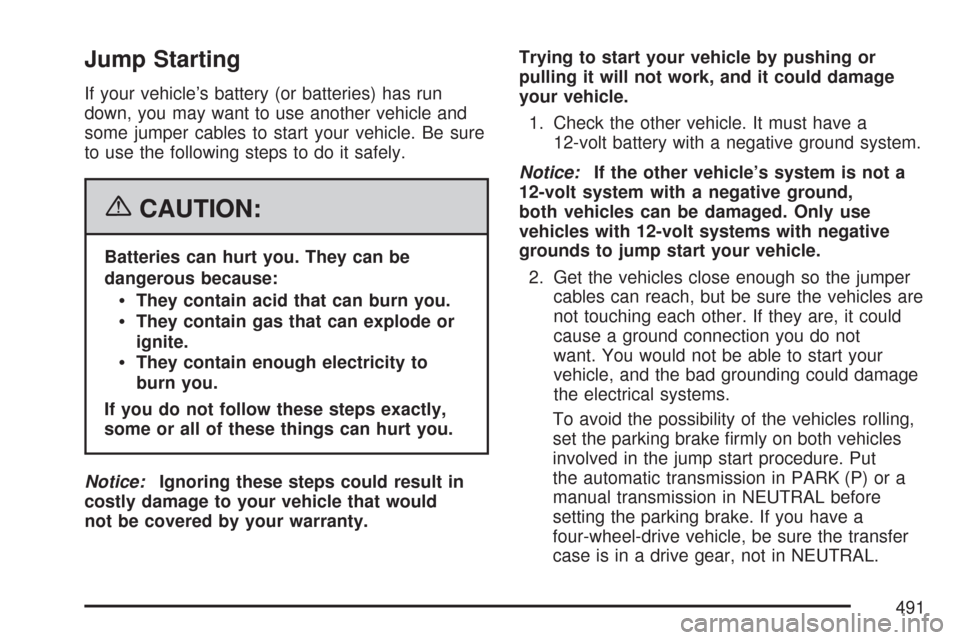
Jump Starting
If your vehicle’s battery (or batteries) has run
down, you may want to use another vehicle and
some jumper cables to start your vehicle. Be sure
to use the following steps to do it safely.
{CAUTION:
Batteries can hurt you. They can be
dangerous because:
They contain acid that can burn you.
They contain gas that can explode or
ignite.
They contain enough electricity to
burn you.
If you do not follow these steps exactly,
some or all of these things can hurt you.
Notice:Ignoring these steps could result in
costly damage to your vehicle that would
not be covered by your warranty.Trying to start your vehicle by pushing or
pulling it will not work, and it could damage
your vehicle.
1. Check the other vehicle. It must have a
12-volt battery with a negative ground system.
Notice:If the other vehicle’s system is not a
12-volt system with a negative ground,
both vehicles can be damaged. Only use
vehicles with 12-volt systems with negative
grounds to jump start your vehicle.
2. Get the vehicles close enough so the jumper
cables can reach, but be sure the vehicles are
not touching each other. If they are, it could
cause a ground connection you do not
want. You would not be able to start your
vehicle, and the bad grounding could damage
the electrical systems.
To avoid the possibility of the vehicles rolling,
set the parking brake �rmly on both vehicles
involved in the jump start procedure. Put
the automatic transmission in PARK (P) or a
manual transmission in NEUTRAL before
setting the parking brake. If you have a
four-wheel-drive vehicle, be sure the transfer
case is in a drive gear, not in NEUTRAL.
491
Page 492 of 634
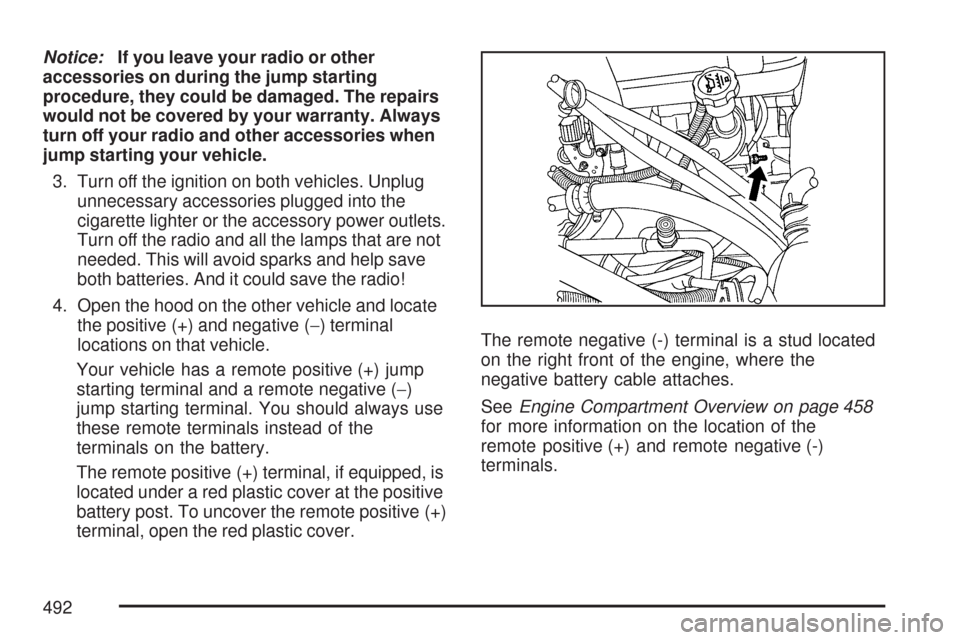
Notice:If you leave your radio or other
accessories on during the jump starting
procedure, they could be damaged. The repairs
would not be covered by your warranty. Always
turn off your radio and other accessories when
jump starting your vehicle.
3. Turn off the ignition on both vehicles. Unplug
unnecessary accessories plugged into the
cigarette lighter or the accessory power outlets.
Turn off the radio and all the lamps that are not
needed. This will avoid sparks and help save
both batteries. And it could save the radio!
4. Open the hood on the other vehicle and locate
the positive (+) and negative (−) terminal
locations on that vehicle.
Your vehicle has a remote positive (+) jump
starting terminal and a remote negative (−)
jump starting terminal. You should always use
these remote terminals instead of the
terminals on the battery.
The remote positive (+) terminal, if equipped, is
located under a red plastic cover at the positive
battery post. To uncover the remote positive (+)
terminal, open the red plastic cover.The remote negative (-) terminal is a stud located
on the right front of the engine, where the
negative battery cable attaches.
SeeEngine Compartment Overview on page 458
for more information on the location of the
remote positive (+) and remote negative (-)
terminals.
492
Page 493 of 634
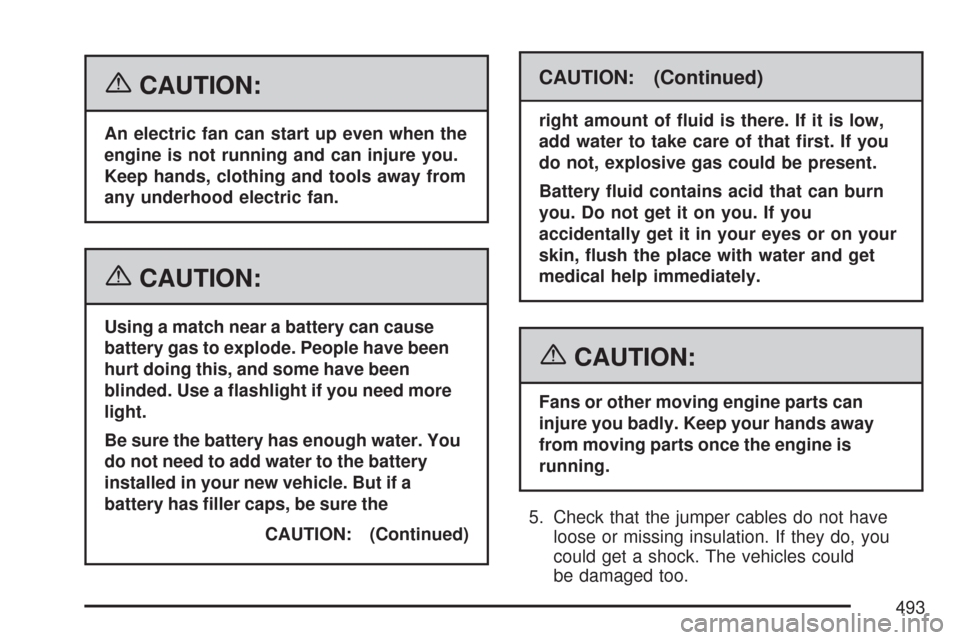
{CAUTION:
An electric fan can start up even when the
engine is not running and can injure you.
Keep hands, clothing and tools away from
any underhood electric fan.
{CAUTION:
Using a match near a battery can cause
battery gas to explode. People have been
hurt doing this, and some have been
blinded. Use a �ashlight if you need more
light.
Be sure the battery has enough water. You
do not need to add water to the battery
installed in your new vehicle. But if a
battery has �ller caps, be sure the
CAUTION: (Continued)
CAUTION: (Continued)
right amount of �uid is there. If it is low,
add water to take care of that �rst. If you
do not, explosive gas could be present.
Battery �uid contains acid that can burn
you. Do not get it on you. If you
accidentally get it in your eyes or on your
skin, �ush the place with water and get
medical help immediately.
{CAUTION:
Fans or other moving engine parts can
injure you badly. Keep your hands away
from moving parts once the engine is
running.
5. Check that the jumper cables do not have
loose or missing insulation. If they do, you
could get a shock. The vehicles could
be damaged too.
493
Page 494 of 634
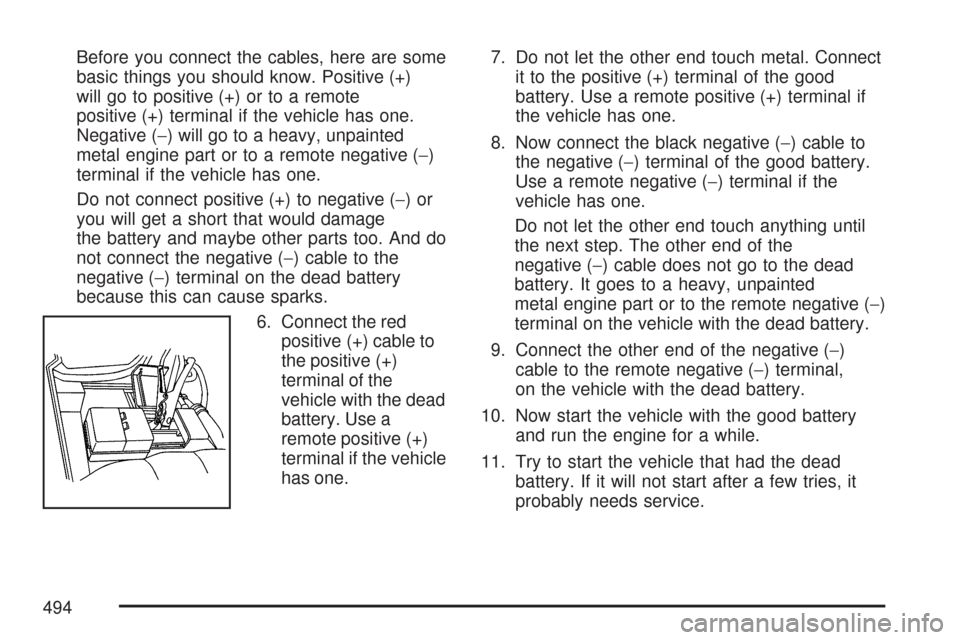
Before you connect the cables, here are some
basic things you should know. Positive (+)
will go to positive (+) or to a remote
positive (+) terminal if the vehicle has one.
Negative (−) will go to a heavy, unpainted
metal engine part or to a remote negative (−)
terminal if the vehicle has one.
Do not connect positive (+) to negative (−)or
you will get a short that would damage
the battery and maybe other parts too. And do
not connect the negative (−) cable to the
negative (−) terminal on the dead battery
because this can cause sparks.
6. Connect the red
positive (+) cable to
the positive (+)
terminal of the
vehicle with the dead
battery. Use a
remote positive (+)
terminal if the vehicle
has one.7. Do not let the other end touch metal. Connect
it to the positive (+) terminal of the good
battery. Use a remote positive (+) terminal if
the vehicle has one.
8. Now connect the black negative (−) cable to
the negative (−) terminal of the good battery.
Use a remote negative (−) terminal if the
vehicle has one.
Do not let the other end touch anything until
the next step. The other end of the
negative (−) cable does not go to the dead
battery. It goes to a heavy, unpainted
metal engine part or to the remote negative (−)
terminal on the vehicle with the dead battery.
9. Connect the other end of the negative (−)
cable to the remote negative (−) terminal,
on the vehicle with the dead battery.
10. Now start the vehicle with the good battery
and run the engine for a while.
11. Try to start the vehicle that had the dead
battery. If it will not start after a few tries, it
probably needs service.
494
Page 495 of 634
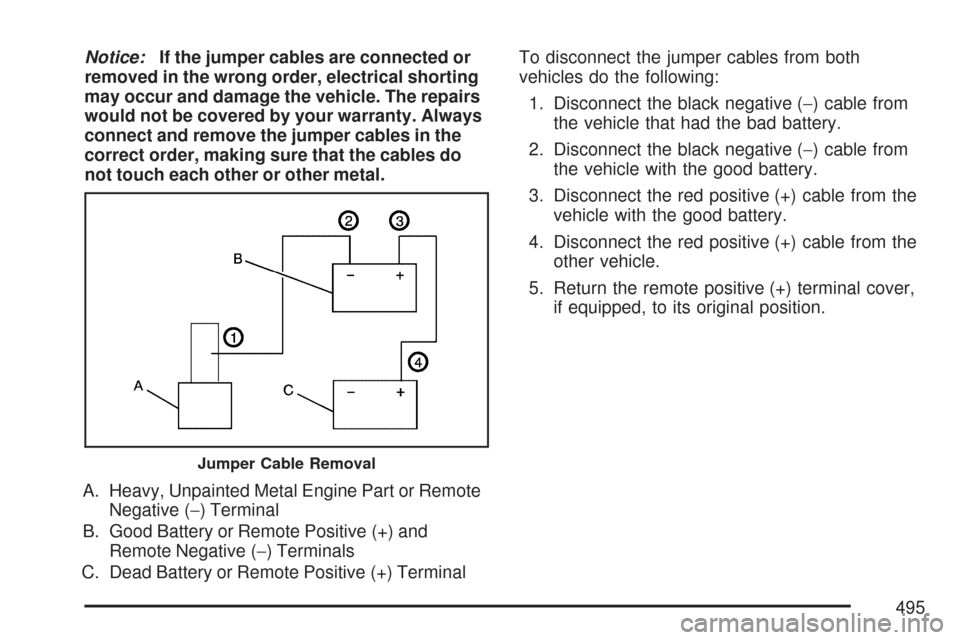
Notice:If the jumper cables are connected or
removed in the wrong order, electrical shorting
may occur and damage the vehicle. The repairs
would not be covered by your warranty. Always
connect and remove the jumper cables in the
correct order, making sure that the cables do
not touch each other or other metal.
A. Heavy, Unpainted Metal Engine Part or Remote
Negative (−) Terminal
B. Good Battery or Remote Positive (+) and
Remote Negative (−) Terminals
C. Dead Battery or Remote Positive (+) TerminalTo disconnect the jumper cables from both
vehicles do the following:
1. Disconnect the black negative (−) cable from
the vehicle that had the bad battery.
2. Disconnect the black negative (−) cable from
the vehicle with the good battery.
3. Disconnect the red positive (+) cable from the
vehicle with the good battery.
4. Disconnect the red positive (+) cable from the
other vehicle.
5. Return the remote positive (+) terminal cover,
if equipped, to its original position.
Jumper Cable Removal
495
Page 496 of 634
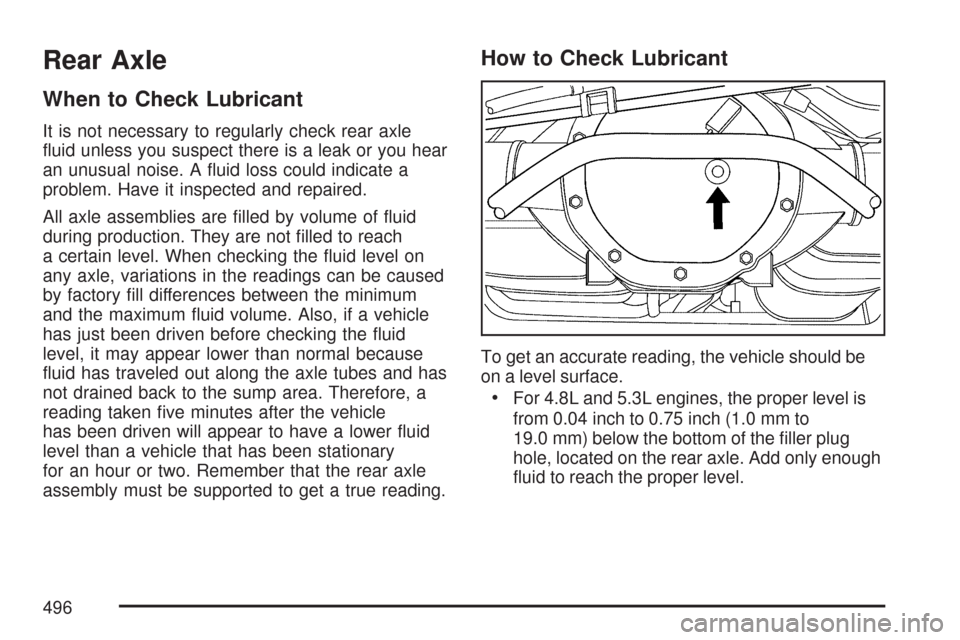
Rear Axle
When to Check Lubricant
It is not necessary to regularly check rear axle
�uid unless you suspect there is a leak or you hear
an unusual noise. A �uid loss could indicate a
problem. Have it inspected and repaired.
All axle assemblies are �lled by volume of �uid
during production. They are not �lled to reach
a certain level. When checking the �uid level on
any axle, variations in the readings can be caused
by factory �ll differences between the minimum
and the maximum �uid volume. Also, if a vehicle
has just been driven before checking the �uid
level, it may appear lower than normal because
�uid has traveled out along the axle tubes and has
not drained back to the sump area. Therefore, a
reading taken �ve minutes after the vehicle
has been driven will appear to have a lower �uid
level than a vehicle that has been stationary
for an hour or two. Remember that the rear axle
assembly must be supported to get a true reading.
How to Check Lubricant
To get an accurate reading, the vehicle should be
on a level surface.
For 4.8L and 5.3L engines, the proper level is
from 0.04 inch to 0.75 inch (1.0 mm to
19.0 mm) below the bottom of the �ller plug
hole, located on the rear axle. Add only enough
�uid to reach the proper level.
496
Page 497 of 634
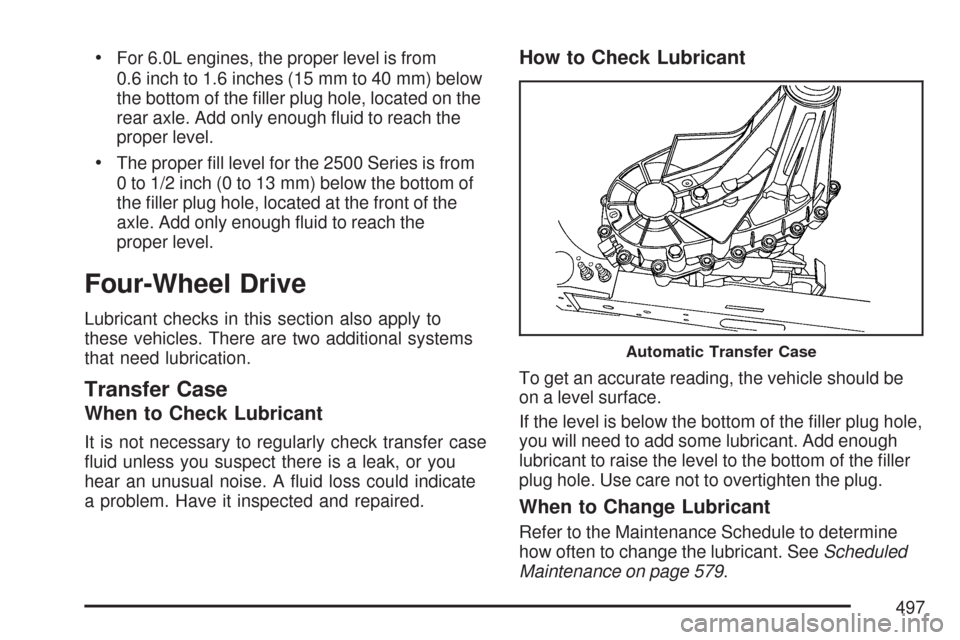
For 6.0L engines, the proper level is from
0.6 inch to 1.6 inches (15 mm to 40 mm) below
the bottom of the �ller plug hole, located on the
rear axle. Add only enough �uid to reach the
proper level.
The proper �ll level for the 2500 Series is from
0 to 1/2 inch (0 to 13 mm) below the bottom of
the �ller plug hole, located at the front of the
axle. Add only enough �uid to reach the
proper level.
Four-Wheel Drive
Lubricant checks in this section also apply to
these vehicles. There are two additional systems
that need lubrication.
Transfer Case
When to Check Lubricant
It is not necessary to regularly check transfer case
�uid unless you suspect there is a leak, or you
hear an unusual noise. A �uid loss could indicate
a problem. Have it inspected and repaired.
How to Check Lubricant
To get an accurate reading, the vehicle should be
on a level surface.
If the level is below the bottom of the �ller plug hole,
you will need to add some lubricant. Add enough
lubricant to raise the level to the bottom of the �ller
plug hole. Use care not to overtighten the plug.
When to Change Lubricant
Refer to the Maintenance Schedule to determine
how often to change the lubricant. SeeScheduled
Maintenance on page 579.
Automatic Transfer Case
497
Page 498 of 634
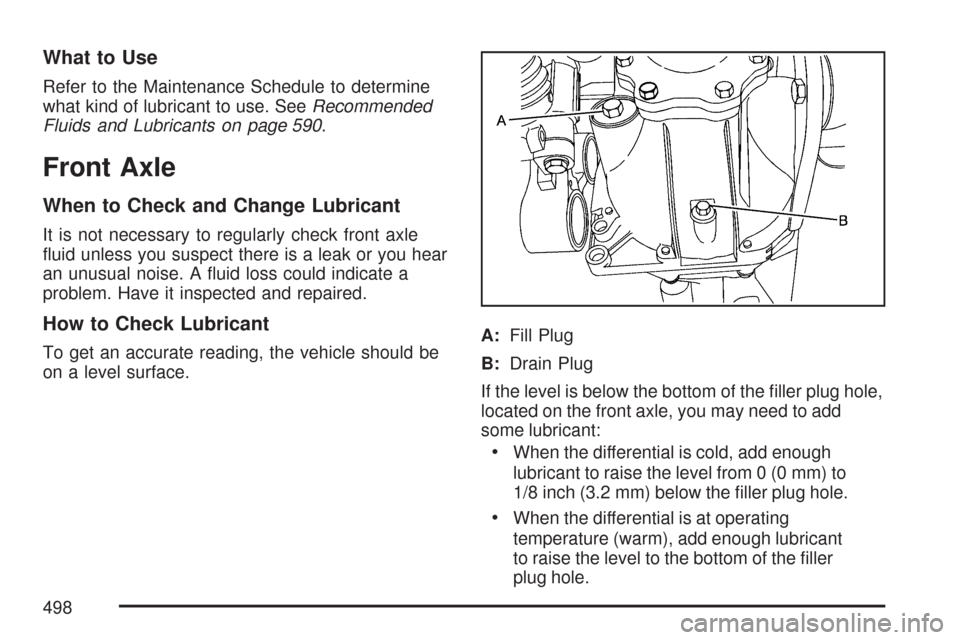
What to Use
Refer to the Maintenance Schedule to determine
what kind of lubricant to use. SeeRecommended
Fluids and Lubricants on page 590.
Front Axle
When to Check and Change Lubricant
It is not necessary to regularly check front axle
�uid unless you suspect there is a leak or you hear
an unusual noise. A �uid loss could indicate a
problem. Have it inspected and repaired.
How to Check Lubricant
To get an accurate reading, the vehicle should be
on a level surface.A:Fill Plug
B:Drain Plug
If the level is below the bottom of the �ller plug hole,
located on the front axle, you may need to add
some lubricant:
When the differential is cold, add enough
lubricant to raise the level from 0 (0 mm) to
1/8 inch (3.2 mm) below the �ller plug hole.
When the differential is at operating
temperature (warm), add enough lubricant
to raise the level to the bottom of the �ller
plug hole.
498
Page 499 of 634
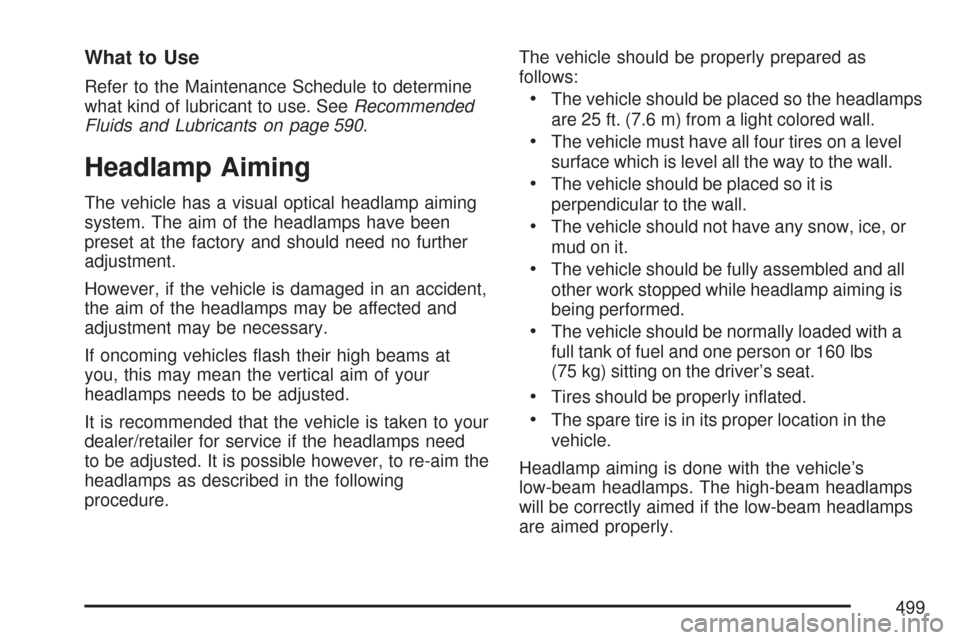
What to Use
Refer to the Maintenance Schedule to determine
what kind of lubricant to use. SeeRecommended
Fluids and Lubricants on page 590.
Headlamp Aiming
The vehicle has a visual optical headlamp aiming
system. The aim of the headlamps have been
preset at the factory and should need no further
adjustment.
However, if the vehicle is damaged in an accident,
the aim of the headlamps may be affected and
adjustment may be necessary.
If oncoming vehicles �ash their high beams at
you, this may mean the vertical aim of your
headlamps needs to be adjusted.
It is recommended that the vehicle is taken to your
dealer/retailer for service if the headlamps need
to be adjusted. It is possible however, to re-aim the
headlamps as described in the following
procedure.The vehicle should be properly prepared as
follows:
The vehicle should be placed so the headlamps
are 25 ft. (7.6 m) from a light colored wall.
The vehicle must have all four tires on a level
surface which is level all the way to the wall.
The vehicle should be placed so it is
perpendicular to the wall.
The vehicle should not have any snow, ice, or
mud on it.
The vehicle should be fully assembled and all
other work stopped while headlamp aiming is
being performed.
The vehicle should be normally loaded with a
full tank of fuel and one person or 160 lbs
(75 kg) sitting on the driver’s seat.
Tires should be properly in�ated.
The spare tire is in its proper location in the
vehicle.
Headlamp aiming is done with the vehicle’s
low-beam headlamps. The high-beam headlamps
will be correctly aimed if the low-beam headlamps
are aimed properly.
499
Page 500 of 634
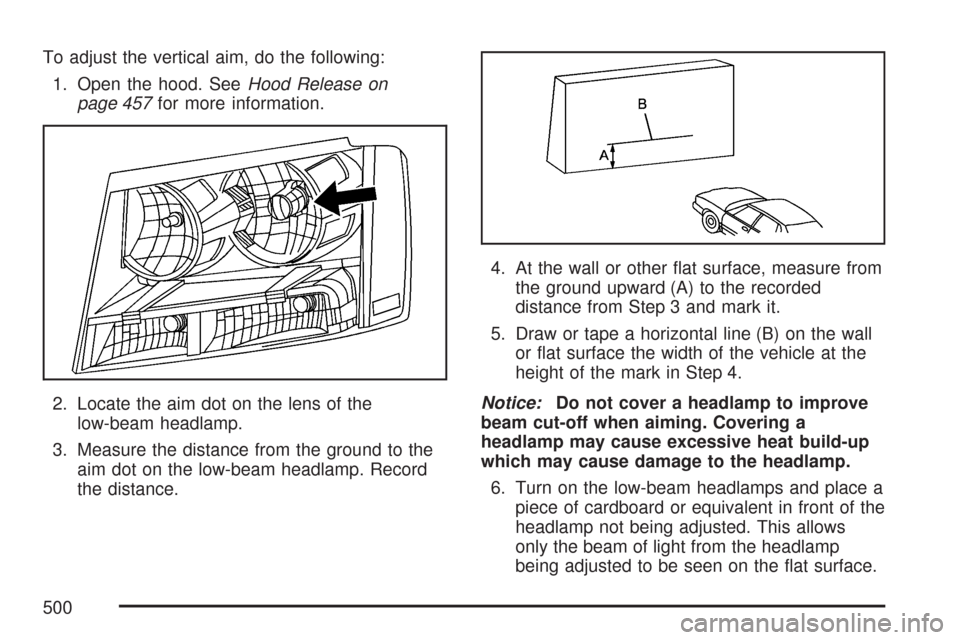
To adjust the vertical aim, do the following:
1. Open the hood. SeeHood Release on
page 457for more information.
2. Locate the aim dot on the lens of the
low-beam headlamp.
3. Measure the distance from the ground to the
aim dot on the low-beam headlamp. Record
the distance.4. At the wall or other �at surface, measure from
the ground upward (A) to the recorded
distance from Step 3 and mark it.
5. Draw or tape a horizontal line (B) on the wall
or �at surface the width of the vehicle at the
height of the mark in Step 4.
Notice:Do not cover a headlamp to improve
beam cut-off when aiming. Covering a
headlamp may cause excessive heat build-up
which may cause damage to the headlamp.
6. Turn on the low-beam headlamps and place a
piece of cardboard or equivalent in front of the
headlamp not being adjusted. This allows
only the beam of light from the headlamp
being adjusted to be seen on the �at surface.
500